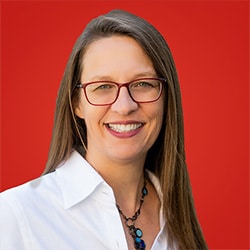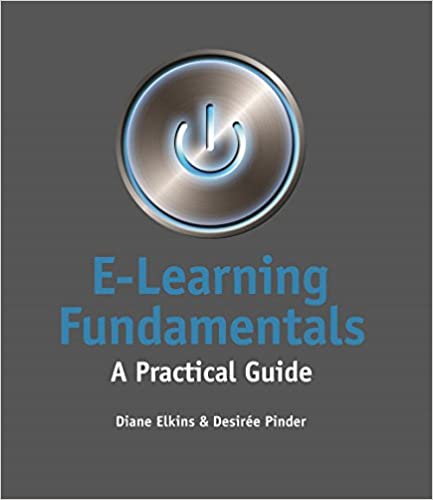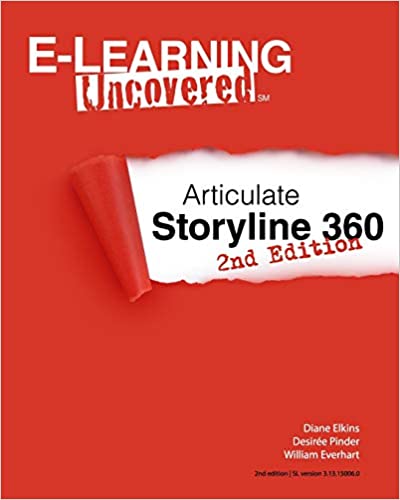Diane Elkins, founder of Artisan E-Learning and E-Learning Uncovered, is passionate about helping others design thoughtful, equitable, and impactful learning experiences. She has over two decades of experience in the e-learning industry, speaks regularly at national conferences, and is co-author of E-Learning Fundamentals: A Practical Guide and the E-Learning Uncovered book series.
In this episode of the Leading Learning Podcast, co-host Jeff Cobb talks with return guest Diane Elkins about the likely long-term implications of the pandemic-driven, massive shift to online learning. They discuss meaningful interactivity; accessibility; diversity, equity, and inclusion; and why Diane favors the terms “access” and “ability.” They also talk about augmented, virtual, and mixed reality, and why it’s important for tech tools to add value, not just a cool factor.
To tune in, listen below. To make sure you catch all future episodes, be sure to subscribe via RSS, Apple Podcasts, Spotify, Stitcher Radio, iHeartRadio, PodBean, or any podcatcher service you may use (e.g., Overcast). And, if you like the podcast, be sure to give it a tweet.
Listen to the Show
Access the Transcript
Download a PDF transcript of this episode’s audio.
Read the Show Notes
[00:00] – Intro
COVID’s Impact on E-Learning
[01:35] – We are a time when e-learning has enjoyed a surge unlike anything we’ve seen before. Does what’s happened because of COVID-19 represent a net gain or a net loss for online learning?
Overall, it’s a net gain, but there are ups and downs. The requirement to go online broke through many barriers that have existed for years, including bureaucratic and financial barriers. Change that might have taken three years without the pandemic happened in three months because of COVID. Organizations have been able to move forward very rapidly.
COVID also broke down assumption about what can be taught online. Not everything is perfect for e-learning, but a lot of preconceived notions and prejudices around e-learning have been broken down. Now many experiences are online, and organizations are reaching more people. Geographic reach is hugely beneficial as the move online removed so many barriers (travel, money, time) for those served by learning businesses.
It’s opened it up geographically. It’s opened it up internationally. It’s reduced socioeconomic barriers…. So just the reach and the equity of being able to get training in the hands of more people without the huge financial and lifestyle barriers of traveling to training has been massive.
Diane Elkins
E-learning Versus In-Person Training
[05:15] – Are people are coming around to the idea that e-learning can be as effective and potentially better than what happens in the classroom?
People are more open to having a conversation about the effectiveness of e-learning. There will still be some topics that are better in the classroom, and there will always be people who prefer the classroom. It can be a challenge to sit at your computer and look at a screen all day. Going to a training shakes things up and gives you better networking opportunities. There’s room for both classroom and e-learning. Diane isn’t hearing anyone asserting that online training isn’t as effective.
Good design is good design. Bad design is bad design. So a poorly designed e-learning course is not going to be better. A poorly designed classroom course isn’t going to be better.
Diane Elkins
So much was done so quickly in the second quarter of 2020 that some subpar offerings were put out there. For the first time in the history of the world, instructional designers and instructional technologists were considered essential personnel. They had to work so quickly that what they developed wasn’t always ideal.
Now is a great time to look and see what’s working so we can move forward more strategically. We need to move from survival mode to thriving mode and think about the best fit.
Current Organizational Struggles with E-learning
[07:33] – Many organizations did what they could without instructional design help early in the pandemic. In general, what have you seen organizations struggle with the most as they’ve had to move to creating and delivering much more online learning than they have in the past (with instructional design help or not)?
Here is some of what Diane has seen organizations struggle with:
- Doing polls for polls’ sake
People sometimes feel obligated to use polls. If you have something worth polling, great, but you don’t need a poll necessarily. - Taking the same slides from in-person and putting them online
Most people have lousy slides. In a physical classroom, the speaker is the primary visual and can overcome suboptimal slides. Online, it’s harder to get around bad slides. - Saying you want the experience to be interactive
If you want people to know that the experience will be interactive, interact. If they’re not interacting within the first six minutes, then you’re setting the tone for them to sit back and be passive.
There are a lot of things people can do to make the experience better online. People put up with a lot of bad everything during the pandemic, but, as we emerge, people are going to decide what offerings and organizations to stick with. Evaluating quality matters, and this doesn’t just mean your production values.
People will gravitate toward the solutions that solve their problems. So if your one-hour Webinar has 20 minutes of intro, that’s not going to keep people. What problem of theirs are you solving? What decision are you going to help them make? What thing that they care about will they be better at tomorrow than they are today? If you’re that person, it doesn’t matter as much if your production values are smaller. Think about when you look at a YouTube video to learn something. You care that you walked away knowing what to do, even if the person wasn’t perfectly polished.
Diane Elkins
Current Learner Struggles with E-learning
[12:10] – What’s your sense of the average learner? What might they be struggling with as they’ve shifted to doing more learning online?
Zoom fatigue is real. People working in an office have reasons to get up and break up their day. Diane is happy that now people turn on their video cameras more than ever before. That’s helped people get to know each other a little bit better and makes them more likely to ask a question in an online learning context. But she recommends we also make it okay for people not to turn on their video at times.
One of the advantages of self-paced e-learning is that the learner can move around, do it on the couch, outside, while on a treadmill, etc. People will go back to things that make their lives easier, but, if you waste their time, they won’t return to what you offer.
The State of E-learning: Now Versus a Decade Ago
[15:16] – How do you describe the state of e-learning now versus a decade ago? Where have we made significant progress in e-learning being a high-quality, effective approach, and where is there still a lot of work to be done to realize the potential of online learning?
The biggest change is that the development tools for e-learning are easier to use, and that’s a blessing and a curse. The blessing is that it’s made it possible for any number of organizations to offer e-learning, even if they can’t have to hire a programmer. The curse is that it puts the tools in hands of people who don’t know how to use them well.
We need to be careful about the value of instructional design in the process. Technologically speaking, e-learning is easier to use and consume. People can use their tablets and their mobile devices, but that also presents challenges. You need to look at how you can provide a great experience that works on a phone and a big monitor—and not all tools are good at that. In many cases, you have to use really purposeful design.
Cammy Bean coined the term called “clicky-clicky bling-bling,” which describes putting in clicks or coolness just for coolness. This is an area we’re still struggling with. There are some really cool things happening in augmented reality (AR), and AR can be used in really effective, strategic ways, but it can also be a flash in the pan. It comes down to being strategic in our design and development of online learning.
Accessibility in E-Learning
[18:20] – You’ve talked on the Leading Learning Podcast before about common mistakes organizations make when they’re developing e-learning experiences. Accessibility is an area that tends to be overlooked. Can you give us an overview of how you think about accessibility and the issues tend to be with how organizations address it?
Instructional designers and e-learning developers make design choices every day that will determine whether or not somebody has the chance to get better at their job. Most people would agree that everybody has that right to learn and get better at their job. Yet, if a slide doesn’t have adequate color contrast, then everybody has a right to get good at their jobs unless they can’t read the slide.
We are making decisions, not realizing that we might be designing for people with our set of abilities. We’re designing for people like us. And that’s where so much of diversity, equity, and inclusion runs into problems, is when people assume that their experience is the norm, and they make decisions based on their experience. So, if we want to be inclusive, if we want to be equitable, we need to ask ourselves, “Am I designing a course that is throwing up barriers to learning?”
Diane Elkins
Sometimes the obstacle is not knowing to providing accessible learning, and Diane admits it took her 10 years in the industry to really tune into accessibility. Technology is another obstacle to accessible learning. There’s a lot to learn, and it takes work, but it doesn’t have to be scary or intimidating.
Another obstacle is people assuming they don’t have anybody in their organization who has a disability or assuming somebody with a disability couldn’t do the job. But it’s not the place of learning designer or developer to decide whether somebody can or can’t do something. We can’t assume to know what somebody can and can’t do because there are so many hidden disabilities. There’s also a stigma with self-identifying.
Someone recently said to Diane, “All ability is temporary.” We need to remember that ability is a spectrum, and there are many ways that we can throw up barriers without realizing it.
If we want to take advantage of the groundswell of support around diversity, equity, and inclusion (DEI), we need to make sure that ability is part of the conversation. Diane has stopped using the word accessibility because she thinks it comes with a lot of baggage. People have preconceived notions that accessibility either applies to them or doesn’t. Ability is too often not part of the DEI conversation. Many designers and developers are trying to use more representative images from a race or a gender perspective, but they’re not thinking ability.
Access and Ability
[25:12] – Do you prefer the term “ability” to “disability” or “accessibility”?
Yes, and, along with the “ability,” the other term Diane uses is “access.” The term “accessibility” has baggage. By framing a conversation about “equal access” instead of “accessibility,” the conversation goes very differently. She’s started talking about access and equal access because it opens up people’s minds. If you’re a learning business, you can focus on ability, accessibility, and access because it’s both a competitive advantage and the right thing to do. Accessibility is having its day. Be part of the conversation, or you’ll be left behind.
Bringing Attention to Accessibility
[26:29] – It seems like more learning management systems and technology companies are now tuned into Section 508 and Web Content Accessibility Guidelines (WCAG), though there’s still quite a way to go.
E-learning was years behind in mobile design and responsive design. E-learning is also running behind the rest of the world in terms of accessibility. It’s getting better, but it’s not where we need to be yet.
Very often e-learning is like the little brother running behind the cool kids.
Diane Elkins
From a DEI perspective, the conversation is shifting from “It’s the right thing to do” to “It’s the law.” The only formal law we have is Section 508, which only applies to federal government communication. Many states have their own laws, but those apply only to state communication. However, case law is starting to change the situation. There are more and more lawsuits coming out over Web sites. There are organizations that are using automated systems to scan Web sites and find flaws and then send letters from lawyers.
Check out the video on learning management system (LMS) accessibility, created by Nicolas Steenhout. In 2020, we made the video available to attendees as a prelude to our annual Live Review event, which is run by ReviewMyLMS.
[31:01] – How do you keep up with trends and changes in e-learning? What are some of your go-to sources and resources?
Diane follows and recommends others follow these three organizations:
All three organizations have blogs, conferences, newsletters, magazines, free Webinars, paid Webinars, and more. Even if using just the free stuff, there offer so much.
Her other big source is LinkedIn. Diane recommends connecting with people who care about topics and issues you care about or area interested in. Then you’ll see the articles they post. You can type in #accessibility to find all kinds of resources. Over time, you can shape your feed to show the types of things you’re interested in.
Exciting Trends in E-learning
[33:06] – What are the learning trends and developments that have you most excited right now?
Diane has had her eye on augmented reality (AR) and virtual reality (VR) for quite a while, but at Artisan E-Learning they haven’t done much with either yet. However, they are actively looking for the right business case for AR or VR to do something that’s a true improvement over other technologies.
What excites Diane isn’t the coolness of the technology, but when it’s used in a really smart way and in case where another simpler technology wouldn’t get you as far. Everything’s getting easier, but AR and VR are still expensive. You need to make sure that people are getting something meaningful for that extra investment.
[37:36] – Wrap-up
Diane Elkins is co-founder of Artisan E-Learning and E-Learning Uncovered. You can connect with her personally on LinkedIn and see some of the great resources and ideas she shares there.
Also check out Diane’s books: E-Learning Fundamentals: A Practical Guide and E-Learning Uncovered (series).
To make sure you don’t miss new episodes, we encourage you to subscribe via RSS, Apple Podcasts, Spotify, Stitcher Radio, iHeartRadio, PodBean, or any podcatcher service you may use (e.g., Overcast). Subscription numbers give us some visibility into the impact of the podcast.
We’d also be grateful if you would take a minute to rate us on Apple Podcasts at https://www.leadinglearning.com/apple. We personally appreciate reviews and ratings, and they help us show up when people search for content on leading a learning business.
Finally, consider following us and sharing the good word about Leading Learning. You can find us on Twitter, Facebook, and LinkedIn.
Episodes on Related Topics:
- E-Learning Uncovered with Diane Elkins
- Design for How People Learn with Julie Dirksen
- Is E-learning Effective?
- The eLearning Hype Curve with Andy Hicken of Web Courseworks
Additional Resources:
- LMS Accessibility: An Introduction (ReviewMyLMS)




 Go Small to Deliver Big Results: A Look at Microcredentials
Go Small to Deliver Big Results: A Look at Microcredentials
Leave a Reply